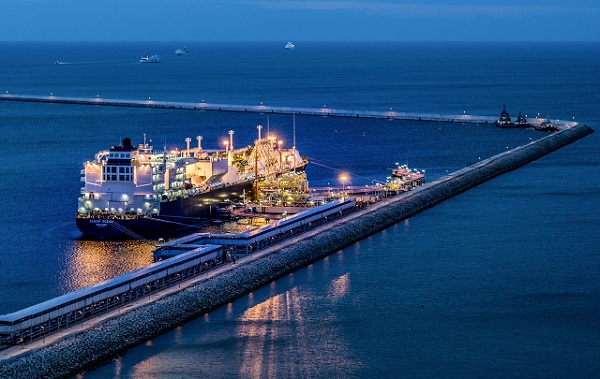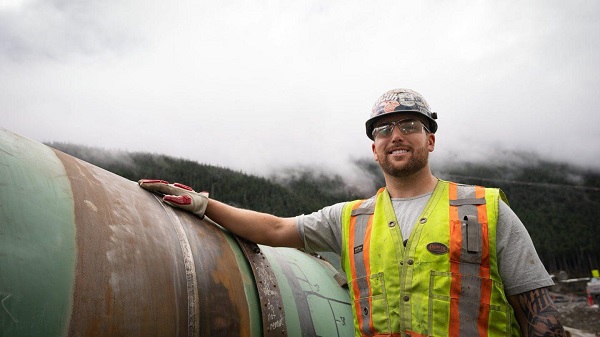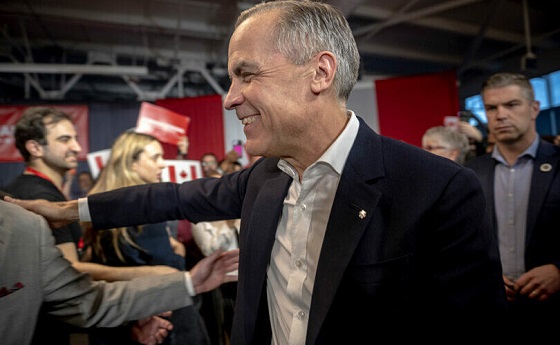Energy
US LNG uncertainty is a reminder of lost Canadian opportunities

From Resource Works
Canada has missed opportunities to supply Europe with LNG due to political missteps and regulatory barriers, despite having the resources and potential.
For almost three years now, Europe has not been able to figure out how it will replace the cheap, plentiful supply of Russian gas it once enjoyed. Since Russia invaded Ukraine, the EU member states have made drastic moves to curtail their reliance on Russian energy, specifically Russian gas.
In an ideal world, the diversification of the EU’s energy supply would have been Canada’s golden opportunity to use its vast LNG capabilities to fill the gap.
Canada has all the right resources at its disposal to become one of the EU’s premier energy sources, with enormous natural gas reserves lying in the ground and shores upon three of the world’s four oceans. The problem is that Canada lacks both the right infrastructure and the necessary political will to get it built.
The fact that Canada is not a favored supplier of LNG to Europe is the consequence of political missteps and a lack of vision at the highest levels of government. It was reported by the Financial Times that outgoing United States President Joe Biden’s freeze on new LNG export permits and clashes with activists have created uncertainty over future supply growth.
Missteps and onerous regulatory barriers have kept Canada shackled and unable to reach its full potential, leaving us on the sidelines as other countries take the place that should have been Canada’s as an energy supplier for the democratic world.
To this day, European leaders like Greek Prime Minister Kyriakos Mitsotakis, German Chancellor Olaf Scholz, and Polish President Andrzej Duda have indicated their openness to adding Canadian LNG to their domestic supply.
However, no plans for supplying Canadian LNG to Europe have come to fruition. The absence of any commitment from the federal government to take those possibilities seriously is the result of decisions that now look like major mistakes in hindsight.
Two of these are cancelled energy projects on the Atlantic coast: the Energy East oil pipeline and the proposed expansion of an LNG terminal in New Brunswick.
Canada’s Pacific coast is now a hub of LNG development, with three planned facilities well underway, and there are hungry markets in Asia ready to receive their products. It is a shame that the Atlantic coast is being left behind during Canada’s burgeoning LNG renaissance. The economic situation in the Maritimes has long been challenging, leading to emigration to the Western provinces and stagnation back at home.
LNG projects in British Columbia have proven to be job machines and drivers of economic revitalization in formerly impoverished regions that were gutted when fishing, mining, and forestry went downhill in the 1980s.
The potential to both help Atlantic Canada level back up economically while becoming the bridge for energy exports to Europe was halted by the cancellation of the Energy East pipeline and a proposed LNG terminal in Saint John, New Brunswick.
Proposed by TransCanada (since renamed to TC Energy) to the National Energy Board in 2014, Energy East would have been a 4,600-kilometer pipeline with the capacity to transport over a million barrels of crude oil from Alberta to refineries in New Brunswick and Quebec. While it is true that Europe is more interested in LNG than crude oil, the completion of one great project encourages more and could have gotten the ball rolling on further energy infrastructure.
Had Energy East been constructed, it would have served as a symbol to investors and energy industry players that Canada was serious about west-to-east projects. Unfortunately, in 2017, TransCanada withdrew from the project due to regulatory disagreements and uncertainty.
In 2019, the federal government passed Bill C-69, AKA the “no more pipelines” law, leading to even more complex and restrictive regulations for new energy projects. When there should have been momentum on energy infrastructure building, there came only more cascading bad news.
A proposed expansion of Repsol’s LNG terminal in Saint John, New Brunswick, another potential gateway for Canadian energy to get through to Europe, was abandoned due to the projected high costs and poor business case.
The idea of LNG on the East Coast making for a poor business case has been repeated by the federal government many times. However, in documents accessed by The Logic, it was revealed that Global Affairs Canada has, in fact, stated the opposite, and that there was great potential to increase rail and pipeline networks on the Atlantic.
Furthermore, Canada is capable of shipping LNG from the Western provinces to the East Coast because of our access to the vast pipeline networks of the United States.
As a result of these regrettable decisions, Canadians can only watch as lost opportunities to provide LNG to the democratic world are filled by other countries. Every downturn or disruption in the energy exports of other countries is a sore reminder of Canada’s lost opportunities.
Canada needs more vision, certainty, and drive when it comes to building the future of Canadian energy. In the words of Newfoundland and Labrador Premier Andrew Furey, “We will be all in on oil and gas for decades and decades to come…because the world needs us to be.”
2025 Federal Election
When it comes to pipelines, Carney’s words flow both ways

 Dan McTeague
Dan McTeague
Well, you’ve got to hand it to Mark Carney. Though he’s only just entered politics — after years of flirting with the idea, while serving on Team Trudeau behind-the-scenes — and despite the fact that he hasn’t been elected to anything yet, he’s become well versed in the ancient political art of speaking out of both sides of his mouth. Like many men seeking high office before him, Carney is happy to say to whoever happens to be in front of him whatever he thinks they want to hear, even if it contradicts what he said to someone else the day before.
Of course, that isn’t so easy to pull off these days. Nowadays pretty much everything a politician says in public is going to pop up on the internet within hours. Which is why it’s been so easy to keep tabs on Carney’s policy flip-flopping.
For just the latest example, last week in Calgary Carney opened his pitch to a sceptical province by saying, “You don’t need to tell me what Alberta is like. I’m from Alberta!” He proclaimed that “Canada has a tremendous opportunity to be the world’s leading energy superpower,” and that “we must invest in our natural strengths and ensure our economic sovereignty!” He promised to “identify projects of national interest,” and fast-track them, while acknowledging that “any major energy project that comes from this great province is going to pass the boundaries of other provinces.”
The implication was that voting for a Carney-led Liberal government would mean a major course correction from the ‘Lost Decade” of Liberal governance, that oil and gas from Alberta should be harnessed to power Canada to prosperity, with pipeline projects (maybe a revived Energy East) spanning every province (presumably over the objections of the government of Quebec, these being projects in the “national interest” and all), and the construction of terminals — of the type for which Trudeau previously said there was no “business case” — enabling us to get Canadian Natural Gas onto tankers bound for Europe and Asia. What else could he have meant by ‘global energy superpower,’ ‘self-sufficiency,’ and the promise to invest in Alberta’s energy infrastructure?
But then Carney found himself being interviewed in Montreal, and his approach was quite different. After his interviewer poked some fun at Carney’s tendency to crib policy proposals from the Conservatives — “do you find Mr. Poilievre has good ideas?” — Carney was asked about his “energy superpower” comments, and he hedged, saying that Canada should work to develop its own resources “if there is social acceptability.” Asked about pipelines specifically, Carney said “We must choose a few projects, a few big projects. Not necessarily pipelines, but maybe pipelines, we’ll see.”
Now, if you think that all of this sounds strangely familiar, you’re not crazy. Carney has been doing this dance since he first stepped out from behind the curtain, saying one thing out west and another back east.
Speaking in B.C. in February he aped a Donald Trump line by saying he wanted Canada to “build, baby, build,” and promised to use “the emergency powers of the federal government to accelerate the major projects that we need in order to build this economy and take on the Americans,” clarifying to CBC that those major projects included pipelines. But then, in a French-language interview, he was asked if he planned to force Quebec to accept a pipeline, and he answered, “I would never impose [a pipeline] on Quebec.”
These examples should be enough to demonstrate that Mark Carney is a Con Man. But who, exactly, is his mark? Is he telling the truth in Quebec, where he’s looking to syphon off support from the Bloc Québécois? Or is he telling the truth in Alberta, where he’d love to snatch a few more urban ridings from the Conservatives?
The answer is that, actually, we’re all his mark. Carney doesn’t really care about Quebec’s sovereignty, or any contentious constitutional question like that. And he certainly has no desire to build pipelines and LNG terminals in order to turn Canada into a global energy superpower. A glance at his long career, as both a public and private sector Net-Zero activist, pressuring both individual corporations and national governments to adopt his environmentalist ideology, will tell you as much.
Once you accept that, you start to notice Carney’s sleight-of-hand on questions of energy and affordability. He’s taking credit for “Axing the Carbon Tax,” when in reality he merely zeroed out part of it, while doubling down on the other half. He’s set it up so that he can bring the Consumer Carbon Tax back whenever he likes, without a vote. Meanwhile, our economy will be slowly strangled by the Industrial Carbon Tax, and our everyday lives will get more expensive as businesses pass the cost down to us.
He remains committed to Bill C-69, the “No More Pipelines Act,” which the Supreme Court said overstepped the federal government’s constitutional authority, which itself shows that his mealy-mouthed talking points on pipelines and energy infrastructure don’t amount to a real commitment to anything. And he still supports the Trudeau government’s emissions caps, which target our Natural Resource Sector, the beating heart of Canada’s economy.
And of course he does, because long ago Mark Carney pledged allegiance to the destructive Net-Zero ideology, and it is that, more than anything else, which is the groundwork for how he will actually govern.
So, whatever you do, don’t buy the con. Mark Carney has spent an entire career, before the start of this campaign, telling us exactly who he is. Don’t let him pull the wool over your eyes now.
Dan McTeague is President of Canadians for Affordable Energy.
Support Dan’s Work to Keep Canadian Energy Affordable!
Canadians for Affordable Energy is run by Dan McTeague, former MP and founder of Gas Wizard. We stand up and fight for more affordable energy.
2025 Federal Election
Mark Carney Wants You to Forget He Clearly Opposes the Development and Export of Canada’s Natural Resources

From Energy Now
At COP26, Mark Carney also said that he thinks “we have both far far too many fossil fuels in the world” and “as much as half of oil reserves, proven oil reserves need to stay in the ground” climate goals.
Mark Carney claims that he supports Canada’s oil and gas industry and wants to see Canada export more of our natural resources. But Carney is yet again lying.
If Carney was sincere, he would immediately commit to the full repeal of the Liberals’ C-69, the ‘No More Pipelines’ Act, C-48, the West Coast Tanker Ban, and the production cap. Instead he doubled down on capping Canadian energy production.
But it’s not just that, Mark Carney has a clear history of opposing Canadian energy and infrastructure projects in favour of his radical anti-energy ideology and his goal of shutting down Canadian energy production.
However, while deliberately fighting against Canadian energy, this high flying hypocrite was having his company, Brookfield Asset Management, invest in some of the largest global pipeline projects in Brazil and the United Arab Emirates.
When asked by Conservative Party Leader Pierre Poilievre at an Industry Committee meeting, if he supported Justin Trudeau’s decision to veto the Northern Gateway pipeline, Mark Carney said “given both environmental and commercial reasons … I think it’s the right decision.”
Then, just six months later at COP26, Mark Carney also said that he thinks “we have both far far too many fossil fuels in the world” and “as much as half of oil reserves, proven oil reserves need to stay in the ground” climate goals.
If this wasn’t enough Mark Carney has now teamed up with Trudeau’s radical anti-energy ministers to finish off Canada’s energy sector, a goal that he has outlined while attending a World Economic Forum event in Davos.
Starting with the radical, self-proclaimed socialist, Steven Guilbeault, who’s history of anti-energy and infrastructure policies is all too familiar to Canadians.
Mark Carney has enabled Steven Guilbeault to do even more damage by promoting him to his Quebec Lieutenant, giving him three new ministerial responsibilities so he can continue his climate crusade against Canadian energy and infrastructure projects.
Canadians remember when Guilbeault said that “I disagree with the [Trans Mountain] pipeline” and that “Canada shouldn’t be investing in new infrastructure for fossil fuels.”
They also remember when he proudly proclaimed that “Our government has made the decision to stop investing in new road infrastructure.” All from a minister who shamed Canadians for owning cars.
Then there is the pipeline hating Jonathan Wilkinson, who Carney appointed as Canada’s Minister of Energy and Natural Resources. Recently, Wilkinson wrote a scathing letter to Canada’s energy leaders for their opposition to the Carney-Trudeau Liberals production cap on Canadian oil and gas.
Despite Canadian industries being subject to unjustified tariffs from the United States, Jonathan Wilkinson recently told reporters that “Everybody’s sort of running around saying, ‘Oh my God, we need a new pipeline, we need a new pipeline.’ The question is, well, why do we need a new pipeline?”
Finally, there is Carney’s new Minister of Environment and Climate Change Terry Duguid. Duguid has doubled down on Mark Carney’s climate radicalism by stating that “a Mark Carney government will maintain the cap on emissions from the production of oil and gas”.
From 2015 to 2021 Carney-Trudeau environmental and anti-industry policies have cancelled over $176 billion in Canadian energy projects, with many more being cancelled afterwards. That means $176 billion worth of jobs and powerful paycheques have been blocked from Canadians so Mark Carney and his Ministers can impose their radical net zero ideology.
-

 2025 Federal Election2 days ago
2025 Federal Election2 days agoBREAKING: THE FEDERAL BRIEF THAT SHOULD SINK CARNEY
-

 2025 Federal Election2 days ago
2025 Federal Election2 days agoCHINESE ELECTION THREAT WARNING: Conservative Candidate Joe Tay Paused Public Campaign
-

 2025 Federal Election1 day ago
2025 Federal Election1 day agoMark Carney Wants You to Forget He Clearly Opposes the Development and Export of Canada’s Natural Resources
-

 International1 day ago
International1 day agoPope Francis’ body on display at the Vatican until Friday
-

 Business2 days ago
Business2 days agoHudson’s Bay Bid Raises Red Flags Over Foreign Influence
-

 2025 Federal Election1 day ago
2025 Federal Election1 day agoCanada’s pipeline builders ready to get to work
-

 2025 Federal Election16 hours ago
2025 Federal Election16 hours agoFormer WEF insider accuses Mark Carney of using fear tactics to usher globalism into Canada
-

 International2 days ago
International2 days agoPope Francis’ funeral to take place Saturday

